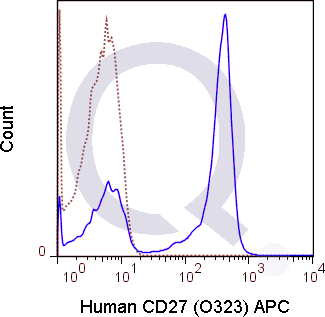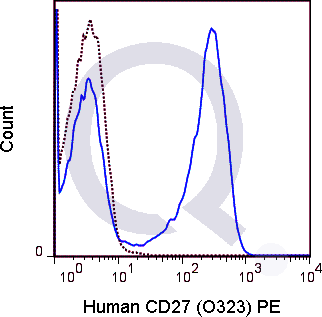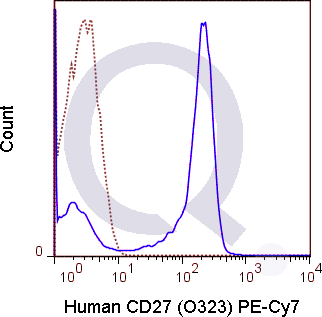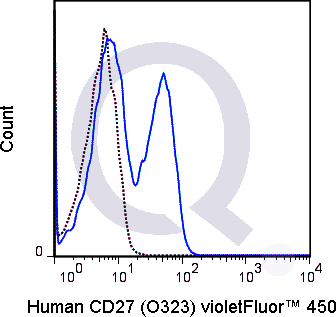Human Anti-CD27 / TNFRSF7 Antibody Product Attributes
CD27 / TNFRSF7 Previously Observed Antibody Staining Patterns
Observed Antibody Staining Data By Tissue Type:
Variations in CD27 / TNFRSF7 antibody staining intensity in immunohistochemistry on tissue sections are present across different anatomical locations. Low, but measureable presence of CD27 / TNFRSF7 could be seen ingerminal center cells in the lymph node and tonsil and hematopoietic cells in the bone marrow. We were unable to detect CD27 / TNFRSF7 in other tissues. Disease states, inflammation, and other physiological changes can have a substantial impact on antibody staining patterns. These measurements were all taken in tissues deemed normal or from patients without known disease.
| CD27 / TNFRSF7 General Information | |
|---|---|
| Alternate Names | |
| CD27, TNFRSF7, T14, S152. LPFS2, TNFRSF7, S152, Tp55 | |
| Curated Database and Bioinformatic Data | |
| Gene Symbol | CD27 |
| Entrez Gene ID | 939 |
| Ensemble Gene ID | ENSG00000139193 |
| RefSeq Protein Accession(s) | XP_011519344, NP_001233, XP_016875722, XP_016875721, XP_016875723 |
| RefSeq mRNA Accession(s) | XM_017020232, NM_001242, XM_017020233, XM_011521042, XM_017020234 |
| RefSeq Genomic Accession(s) | NC_000012, NG_031995, NC_018923 |
| UniProt ID(s) | P26842 |
| UniGene ID(s) | P26842 |
| HGNC ID(s) | 11922 |
| Cosmic ID(s) | CD27 |
| KEGG Gene ID(s) | hsa:939 |
| PharmGKB ID(s) | PA162382107 |
| General Description of CD27 / TNFRSF7. | |
| The O323 antibody reacts with human CD27 (TNFRSF7), a cell surface homodimer of 55 kDa subunits, which provides co-stimulatory signaling in support of the T cell (TCR) and B cell (BCR) receptors. By comparison with CD28, whose TCR co-stimulatory signal can trigger cell proliferation, CD27 signaling appears to promote cell survival and differentiation to effector / memory stages. Also in contrast with CD28, the CD27 receptor may be shed following interaction with its ligand CD70, which is typically expressed on activated dendritic cells, T cells and B cells. With respect to B cells, CD27 is considered to be a phenotypic marker for memory B cells. CD27 has been included within a group of phenotypic markers for identifying human B regulatory cells (Bregs), a cell type proposed to regulate CD4+ T cell proliferation and Foxp3 / CTLA-4 expression in Treg cells.The O323 antibody may be used for analysis of CD27 expression on peripheral T cells, and is frequently used in combination with antibodies for IgD and IgM to distinguish nave vs. memory B cell populations. For identification of Breg cells, this antibody has been used in combination with antibodies for CD25, CD1d, IL-10 and TGF-beta (Kessel et al. 2012. Autoimm. Rev. 11(9): 670-677). The antibody is also reported for cross-reactivity with Baboon, Cynomolgus and Rhesus CD27. | |
Selected References
Limitations and Warranty
| Size | |
|---|---|
| Tag | APC, APC-Cy7, FITC, PE, PE-Cy7, Qfluor™ 630, Unconjugated, V450 |
| Buffer and Stabilizer | 10 mM NaH2PO4, 150 mM NaCl, 0.09% NaN3, 0.1% gelatin, pH7.2, 10 mM NaH2PO4, 150 mM NaCl, 0.09% NaN3, pH 7.2 |
| Product Type | |
| Host | |
| Isotype | |
| Applications | |
| Species | |
| Mass Spec Validated? |
Only logged in customers who have purchased this product may leave a review.




![Anti-CD27 Antibody [O323] - Image 4](https://cdn-enquirebio.pressidium.com/wp-content/uploads/2017/10/enQuire-Bio-QAB36-F-100Tests-anti-CD27-TNFRSF7-antibody-10.png)




Reviews
There are no reviews yet.